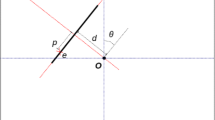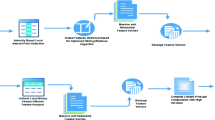Abstract
In this paper we propose a novel approach for detecting interest points invariant to scale and affine transformations. Our scale and affine invariant detectors are based on the following recent results: (1) Interest points extracted with the Harris detector can be adapted to affine transformations and give repeatable results (geometrically stable). (2) The characteristic scale of a local structure is indicated by a local extremum over scale of normalized derivatives (the Laplacian). (3) The affine shape of a point neighborhood is estimated based on the second moment matrix.
Our scale invariant detector computes a multi-scale representation for the Harris interest point detector and then selects points at which a local measure (the Laplacian) is maximal over scales. This provides a set of distinctive points which are invariant to scale, rotation and translation as well as robust to illumination changes and limited changes of viewpoint. The characteristic scale determines a scale invariant region for each point. We extend the scale invariant detector to affine invariance by estimating the affine shape of a point neighborhood. An iterative algorithm modifies location, scale and neighborhood of each point and converges to affine invariant points. This method can deal with significant affine transformations including large scale changes. The characteristic scale and the affine shape of neighborhood determine an affine invariant region for each point.
We present a comparative evaluation of different detectors and show that our approach provides better results than existing methods. The performance of our detector is also confirmed by excellent matching results; the image is described by a set of scale/affine invariant descriptors computed on the regions associated with our points.
Similar content being viewed by others
Explore related subjects
Discover the latest articles, news and stories from top researchers in related subjects.References
Almansa, A. and Lindeberg, T. 2000. Fingerprint enhancement by shape adaptation of scale-space operators with automatic scale selection. IEEE Transactions on Image Processing, 9(12):2027–2042.
Alvarez, L. and Morales, F. 1997. Affine morphological multiscale analysis of corners and multiple junctions. International Journal of Computer Vision, 2(25):95–107.
Baumberg, A. 2000. Reliable feature matching across widely separated views. In Proceedings of the Conference on Computer Vision and Pattern Recognition, Hilton Head Island, South Carolina, USA, pp. 774–781.
Borenstein, E. and Ullman, S. 2002. Class-specific, top-down segmentation. In Proceedings of the 7th European Conference on Computer Vision, Copenhagen, Denmark, pp. 202–215.
Brand, P. and Mohr, R. 1994. Accuracy in image measure. In Proceedings of the SPIE Conference on Videometrics III, S.F. El-Hakim (Ed.). Boston, Massachusetts, USA, vol. 2350, pp. 218–228.
Bretzner, L. and Lindeberg, T. 1998. Feature tracking with automatic selection of spatial scales. Computer Vision and Image Understanding, 71(3):385–392.
Brown, M. and Lowe, D.G. 2002. Invariant features from interest point groups. In The 13th British Machine Vision Conference, Cardiff University, UK, pp. 253–262. Chomat, O., de Verdire, V.C., Hall, D., and Crowley, J. 2000. Local scale selection for Gaussian based description techniques. In Proceedings of the 6th European Conference on Computer Vision, Dublin, Ireland, pp. 117-133.
Cottier, J. 1994. Extraction et appariements robustes des points d'intérêt de deux images non etalonnées.
Crowley, J. 1981.Arepresentation for visual information.PhDthesis, Carnegie Mellon University.
Crowley, J. and Parker, A. 1984. A representation for shape based on peaks and ridges in the difference of low pass transform. IEEE Transactions on Pattern Analysis and Machine Intelligence, 6(2):156–170.
Deriche, R. and Giraudon, G. 1993. A computational approach for corner and vertex detection. International Journal of Computer Vision, 10(2):101–124.
Duda, R. and Hart, P. 1973. Pattern Classification and Scene Analysis. Wiley-Interscience.
Dufournaud, Y., Schmid, C., and Horaud, R. 2000. Matching images with different resolutions. In Proceedings of the Conference on Computer Vision and Pattern Recognition, Hilton Head Island, South Carolina, USA, pp. 612–618.
Förstner, W. 1994. A framework for low level feature extraction. In Proceedings of the 3rd European Conference on Computer Vision, Stockholm, Sweden, pp. 383–394.
Förstner,W. and Gülchm, E. 1987. A fast operator for detection and precise location of distinct points, corners and centres of circular features. In Intercommission Conference on Fast Processing of Photogrammetric Data, Interlaken, Switzerland, pp. 281–305.
Freeman, W. and Adelson, E. 1991. The design and use of steerable filters. IEEE Transactions on Pattern Analysis and Machine Intelligence, 13(9):891–906.
Garding, J. and Lindeberg, T. 1994. Direct estimation of local surface shape in a fixating binocular vision system. In Proceedings of the 3rd European Conference on Computer Vision, Stockholm, Sweden, pp. 365–376.
Harris, C. and Stephens, M. 1988. A combined corner and edge detector. In Alvey Vision Conference, pp. 147–151.
Heitger, F., Rosenthaler, L., von der Heydt, R., Peterhans, E., and Kuebler, O. 1992. Simulation of neural contour mechanism: From simple to end-stopped cells. Vision Research, 32(5):963–981.
Horaud, R., Skordas, T.,and Veillon, F. 1990. Finding geometric and relational structures in an image. In Proceedings of the 1st European Conference on Computer Vision, Antibes, France, pp. 374–384.
Kadir, T. and Brady,M. 2001. Scale, saliency and image description. International Journal of Computer Vision, 45(2):83-105, Kanatani, K. 1998. Geometric information criterion for model selection. International Journal of Computer Vision, 26(3):171–189.
Laptev, I. and Lindeberg, T. 2001. Tracking of multi-state hand models using particle filtering and a hierarchy of multi-scale image features. In Proceedings of Scale Space and Morphology Workshop, Vancouver, Canada, vol. 2106. Lecture Notes in Computer Science, pp. 63–74.
Lazebnik, S., Schmid, C., and Ponce, J. 2003. Sparse texture representation using affine-invariant neighborhoods. In Proceedings of the Conference on Computer Vision and Pattern Recognition, Madison, Wisconsin, USA, pp. 319–324.
Lindeberg, T. 1993. Detecting salient blob-like image structures and their scales with a scale-space primal sketch-A method for focus-of-attention. International Journal of Computer Vision, 11(3):283–318.
Lindeberg, T. 1998. Feature detection with automatic scale selection. International Journal of Computer Vision, 30(2):79–116.
Lindeberg, T. and Garding, J. 1997. Shape-adapted smoothing in estimation of 3-D shape cues from affine deformations of local 2-D brightness structure. Image and Vision Computing, 15(6):415–434.
Lowe, D.G. 1999. Object recognition from local scale-invariant features. In Proceedings of the 7th International Conference on Computer Vision, Kerkyra, Greece, pp. 1150–1157.
Matas, J., Chum, O., Urban, M., and Pajdla, T. 2002. Robust wide baseline stereo from maximally stable extremal regions. In The 13th British Machine Vision Conference, Cardiff University, UK, pp. 384–393.
Mikolajczyk, K. 2002. Interest point detection invariant to affine transformations. PhD thesis, Institut National Polytechnique de Grenoble.
Mikolajczyk, K. and Schmid, C. 2001. Indexing based on scale invariant interest points. In Proceedings of the 8th International Conference on Computer Vision, Vancouver, Canada, pp. 525–531.
Mikolajczyk, K. and Schmid, C. 2002. An affine invariant interest point detector. In Proceedings of the 7th European Conference on Computer Vision, Copenhagen, Denmark, vol. I, pp. 128–142.
Mikolajczyk, K. and Schmid, C. 2003. An performance evaluation of local descriptors. In Proceedings of the Conference on86 Computer Vision and Pattern Recognition, Madison, Wisconsin, USA, pp. 257–264.
Mikolajczyk, K. and Schmid, C. 2003. Shape recognition with edge based features. In Proceedings of the 13th British Machine Vision Conference, Norwich, UK, pp. 779–788.
Pritchett, P. and Zisserman, A. 1998.Wide baseline stereo matching. In Proceedings of the 6th International Conference on Computer Vision, Bombay, India. IEEE Computer Society Press, pp. 754–760.
Rothganger, F., Lazebnik, S., Schmid, C., and Ponce, J. 2003. 3D Object modeling and recognition using affine-invariant patches and multi-view spatial constraints. In Proceedings of the Conference on Computer Vision and Pattern Recognition, Madison, Wisconsin, USA, pp. 272–277.
Schaffalitzky, F. and Zisserman, A. 2001.Viewpoint invariant texture matching and wide baseline stereo. In Proceedings of the 8th International Conference on Computer Vision, Vancouver, Canada, pp. 636–643.
Schaffalitzky, F. and Zisserman, A. 2002. Multi-view matching for unordered image sets. In Proceedings of the 7th European Conference on Computer Vision, Copenhagen, Denmark, pp. 414–431.
Schmid, C. and Mohr, R. 1997. Local grayvalue invariants for image retrieval. IEEE Transactions on Pattern Analysis and Machine Intelligence, 19(5):530–534.
Schmid, C., Mohr, R., and Bauckhage, C. 2000. Evaluation of interest point detectors. International Journal of Computer Vision, 37(2):151–172.
Tell, D. and Carlsson, S. 2002. Combining appearance and topology for wide baseline matching. In Proceedings of the 7th European Conference on Computer Vision, Copenhagen, Denmark, pp. 814–828.
Triggs, B. 2001. Joint feature distributions for image correspondence. In Proceedings of the 8th International Conference on Computer Vision, Vancouver, Canada, pp. 201–208.
Tuytelaars, T. and Gool, L.V. 1999. Content-based image retrieval based on local affinely invariant regions. In Int. Conf. on Visual Information Systems, pp. 493–500.
Tuytelaars, T. and Van Gool, L. 2000.Wide baseline stereo matching based on local, affinely invariant regions. In The 11th British Machine Vision Conference, University of Bristol, UK, pp. 412–425.
Author information
Authors and Affiliations
Rights and permissions
About this article
Cite this article
Mikolajczyk, K., Schmid, C. Scale & Affine Invariant Interest Point Detectors. International Journal of Computer Vision 60, 63–86 (2004). https://doi.org/10.1023/B:VISI.0000027790.02288.f2
Issue Date:
DOI: https://doi.org/10.1023/B:VISI.0000027790.02288.f2




